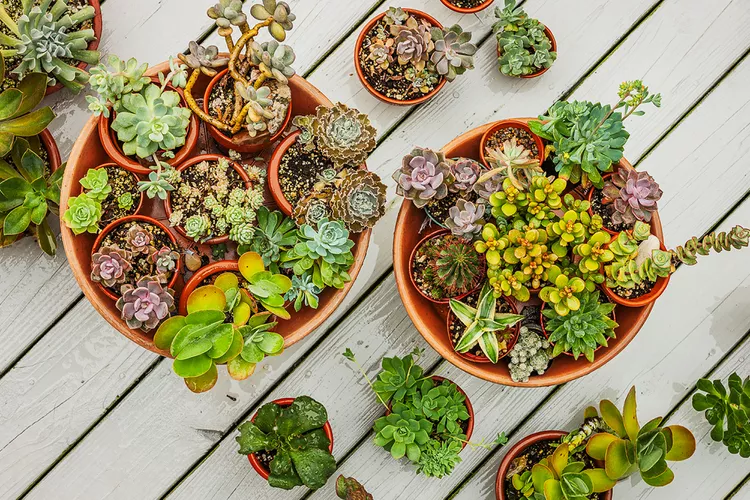It’s a gardening basic: Plants in pots will eventually outgrow the space, which is why it's important to know how to repot succulents when they need it. Repotting every once in a while is necessary to keep plants healthy, and succulents require a little special treatment to move them into a larger container successfully. This guide explains how to know when your succulent needs a new container and includes a step-by-step guide on handling the plant so it makes the transition smoothly.
When to Repot Succulents
The best time to repot succulents is at the beginning of their growing season. Depending on the type of succulent, the growing season begins in the early spring or early fall. Don’t repot a succulent when it’s dormant. A dormant succulent is resting up for the return of its growing season. You may harm it by repotting it mid-nap.
Succulents that go dormant in the winter include sedum, echeveria, kalanchoe, and agave. They are best repotted in the spring. Succulents that go dormant in the summer include aloe, aeonium, haworthia, and senecio, so they are best repotted in the fall.
Don’t repot a succulent that’s blooming, either. Disturbing it will interrupt the blooming process. Repotting a succulent may even make the blooms fall off the plant prematurely. Let those flowers bloom and fade before moving the succulent into a new pot.
Signs a Succulent Needs Repotting
These are signs that you need to move your succulent plant to a new, larger pot.
Growth has slowed down or stopped. If your succulent appears to have stopped growing even though you gave it the right amounts of sun and water, it may be because it’s in a too-small pot of worn-out soil. A larger pot with fresh soil provides nutrition for the succulent and room for its roots to grow.
Water drains from the pot faster than it used to. This could mean the succulent is rootbound, and little soil remains in the pot to hold water. The old pot may be full of roots that have displaced the soil.
You can see roots growing out of the pot. If you see roots on the surface of the potting soil or poking out of the drainage hole at the bottom of the pot, the succulent has outgrown its pot and needs a larger one to keep growing.
You just bought it. New succulents sometimes come in too-small pots full of tired potting mix. Many nurseries use potting mixes that are heavy with peat moss to lighten the shipping weight of plants. Peat isn’t the best growing medium for succulents. Put your new succulent in a new pot with a high-quality, well-draining succulent mix.
It has been in the same pot for more than five years. Succulents should be repotted every two or three years, depending on the variety and growth rate. Even if you see no other signs indicating a succulent needs repotting, put your plant in a pot of new, fresh soil. You’ll give the succulent a burst of nutrients to fuel its growth for a few more seasons.
Steps for Repotting Succulents
Here’s how to repot your succulent when the time comes:
- Choose a new pot that is at least 2 inches wider and 2 to 3 inches deeper than the diameter of the succulent.
- Fill the new pot ¾ full with a potting mix made especially for succulents or cacti. You can make your own potting medium by mixing equal parts of compost, coir, and perlite.
- Remove your succulent from its current pot, and gently loosen the roots with your fingers. Lightly brush the old soil off the plant roots.
- Place the plant on top of the soil in the new pot and cover the roots completely with fresh potting mix. Don’t cover any of the leaves with soil or allow them to touch the soil lest they rot.
- Lightly pat down the soil mix to stabilize the succulent in its new pot.
Caring for Succulents After Repotting
After repotting a succulent, give it some special attention.
- Water the newly replanted succulents lightly a day after transplanting them.
- Keep them in a shady spot while they adjust to the new container and growing conditions.
- Wait a few weeks before fertilizing the plant. You want the succulent to put its energy into adapting to its new pot, not putting out new growth.




















